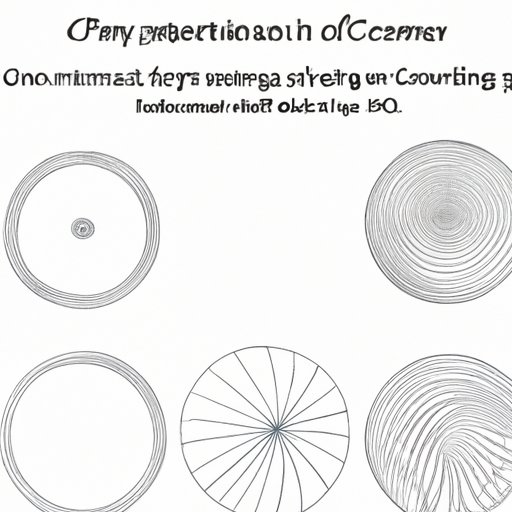
I. Introduction
Drawing a perfect circle is a fundamental skill in art, design, and even math. Whether you’re sketching a logo or creating a mandala, being able to draw a perfect circle is something that can save you a lot of time and frustration. In this guide, we’ll explore different techniques, tools, and tips for drawing a perfect circle, from the basics to more advanced methods.
II. Step-by-Step Guide to Drawing a Perfect Circle
Before we dive into the different techniques for drawing circles, let’s cover the basics. Here’s a simple step-by-step guide to drawing a circle:
1. Start by drawing a dot in the center of where you want the circle to be.
2. Choose a point on the dot and draw a line to where you want the circle’s edge to be.
3. Rotate the paper or your hand while keeping the pen or pencil steady to complete the circle.
While this method works for basic circles, you may find that it’s not perfectly round. Here are some more advanced techniques for perfecting a circle:
– Use a compass: A compass is a tool that consists of two arms, one with a pointed end and one with a pencil or pen holder. Place the pointed end on the dot and rotate the other arm to draw the circle. This allows for a perfectly round circle every time.
– Use a protractor: A protractor is a tool used for measuring angles. However, it can also be used to draw circles by marking off the degrees on the protractor and rotating it around the dot.
– Trace a circular object: Find an object that is the size you want your circle to be and trace around it.

III. Common Mistakes That Stop You From Drawing a Perfect Circle
Even with the right techniques, there are still some common mistakes that can hinder your ability to draw a perfect circle. These include:
– Uneven pressure: Applying uneven pressure to the pen or pencil can cause the circle to be lopsided.
– Shaky hands: Hand tremors can cause the circle to be wobbly or uneven.
– Moving the paper: If you move the paper while drawing the circle, it can cause the circle to be lopsided or skewed.
To avoid these mistakes and improve your technique, try these tips:
– Use your whole arm: Instead of just using your wrist, move your entire arm to keep the pen or pencil steady.
– Use a straight edge: Hold a ruler or another straight object against your hand to keep it steady while drawing the circle.
– Practice: The more you practice, the more comfortable and steady your hand will become.
IV. Tools and Techniques for Drawing a Perfect Circle
In addition to the basic and advanced techniques we covered earlier, there are other tools and techniques you can use to draw a perfect circle. Here are a few examples:
– Stencils: Stencils are pre-cut shapes that can be traced around to create a perfect circle.
– French curves: French curves are plastic or metal templates that can be used to draw smooth and precise curves.
– Grid paper: Grid paper has evenly spaced lines that can help you draw precise shapes and circles.
When it comes to freehand techniques, experiment with different grip types and pen or pencil sizes to find what works best for you.
V. The History and Significance of the Perfect Circle
Circles have been used throughout history in art, religion, and science. In art, circles have often been used to represent unity or infinity. In religion, circles have been used as symbols of spiritual wholeness and completion. In science, circles are used to calculate the area and circumference of shapes.
By learning to draw a perfect circle, you are tapping into a rich history of geometry and symbolism. It can also be a meditative process that helps you focus and center your mind.
VI. The Geometric Science Behind a Perfect Circle
Drawing a perfect circle is more than just applying the right techniques and tools. There’s a mathematical science behind it as well. Pi (π) is a mathematical constant that represents the ratio of a circle’s circumference to its diameter. The radius of a circle is the distance from its center to its edge.
By understanding these concepts, you can deepen your appreciation for circles and their geometry. You can also use this knowledge to create more complex shapes and understand the properties of circles in different contexts.
VII. Finding Your Own Style for Perfect Circles
While it’s important to learn the basics of drawing a perfect circle, it’s also important to find your own style. Every artist approaches circles differently, whether it’s through the pressure they apply, the grip they use, or the tools they prefer. Don’t be afraid to experiment and find what works best for you.
Remember, drawing is not just about perfection, it’s about expression and creativity. Even if your circle is not perfectly round, it can still be a beautiful expression of your art.
VIII. Sketching Perfect Circles in the Digital Age
In today’s digital age, there are many tools available for drawing circles. Most digital art programs have a shape tool that allows you to create a perfect circle with just a few clicks. There are also apps and tools that can help you draw circles on your phone or tablet.
However, it’s still important to learn the basics of drawing circles by hand. This can improve your digital skills as well by giving you a better understanding of the shapes you’re creating.
IX. Conclusion
Drawing a perfect circle is not just a practical skill, it’s also a creative and meditative process. By learning the techniques, tools, and history of circles, you can deepen your appreciation for this fundamental shape. Whether you’re an artist, designer, or math enthusiast, practicing drawing perfect circles can improve your skills and open up new possibilities for your work.
Remember to experiment, find your own style, and enjoy the process of creating your perfect circle.




